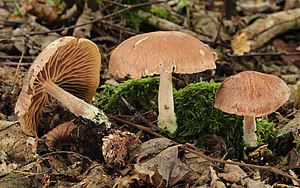Burning Rübling
| Burning Rübling | ||||||||||||
|---|---|---|---|---|---|---|---|---|---|---|---|---|

Burning turnip ( Marasmiellus peronatus ) |
||||||||||||
| Systematics | ||||||||||||
|
||||||||||||
| Scientific name | ||||||||||||
| Marasmiellus peronatus | ||||||||||||
| ( Bolton ) JS Oliveira |
The Burning Rübling ( Marasmiellus peronatus , syn. Gymnopus peronatus , Marasmius urens ) is a fungal art from the family of Omphalotaceae .
features
Macroscopic features
The hat measures 3 to 6 cm in diameter, is convex (umbrella-shaped) when young and later flattens out. He is hygrophan . The surface of the hat takes on shades that range from ocher to reddish-brown or even yellow; towards the middle of the hat, the color darkens into a correspondingly darker brown. Their texture is smooth, fine-grained, dry and has a certain sheen. The brim of the hat is smooth, and with aging it is often corrugated, and the texture is then grooved or even rough-toothed.
The lamellae are pale yellow when young, darken to cream-brown as the fruiting body ripens. Standing at a distance, they are thick, forked and free, so not attached to the stem.
The stalk is 3 to 7.5 cm long and 0.3 to 0.8 cm thick and has dirty white to yellow shaggy hair in the lower half. There is no annulus in the form of a ring or ring remnant. The surface is partly coarse-grained, otherwise smooth. The stem base has hardly any thickening.
The flesh is pale yellow and the consistency of soft-schammig. The smell is weak, unspecific, the taste is usually pungent, rarely also mild or sour.
The spore powder is inamyloid white.
Microscopic features
The elliptical to subcylindrical smooth spores measure (6.5–) 8.5–10 (–11.5) × 3–4 (–4.5) µm and are inamyloid. The length-width ratio is (1.9) 2.1-2.7, on average around 2.4.
The basidia are four-pore, narrow club-shaped, measure 20–40 (–50) × 6–8 µm and have a basal buckle.
The lamellar cutting edge is sterile, i.e. without extensive basidia, but occupied by cheilocystidia . These measure 25–90 × (4.0–) 4.6–5.0 µm, are narrowly club-shaped and apically usually have one or more wart- to finger-shaped outgrowths. These protrusions usually measure 2.0-10 (-20) x 1.0-5.0 µm. If, however, there is only one outgrowth, it can also be thread-like and up to 100 µm long and 2.0–2.5 µm wide. The cell walls of the outgrowths are thin and colorless-hyaline to yellowish.
Pleurocystides occur only scattered on the lamellar surface, are narrowly club-shaped, measure 60–70 × 6.0–8.0 µm and have thin, colorless, hyaline to yellowish cell walls.
The top layer of the hat consists of lying, radial hyphae 3.0–8.0 µm wide. The cell walls are thin, colorless hyaline or pale brown, smooth or encrusted yellow. The end cells of the hat covering layer hyphae show partly scattered, wart-like protuberances, more rarely also longer, cylindrical outgrowths.
Caulocystids are common in the upper part of the stem. They are up to 7 µm wide, more or less thin-walled, colorless-hyaline to somewhat brownish, cylindrical, sometimes constricted, sometimes with swellings and sometimes show wart-like outgrowths.
Buckles are numerous in all braids.
Species delimitation
Because the lamellae turn brown when they mature, there is a risk of confusion with brown-spore lamellar fungi if no spore print is made. Gymnopus impudicus can look similar, but it can be recognized by an unpleasant smell of rotting cabbage. Due to the distant lamellae, there is a risk of confusion with the hygrophan reddish lacquer funnel ( Laccaria laccata ), although the species differ significantly in color.
Ecology and phenology
The species common in Central Europe occurs in deciduous and coniferous forests. The fungus grows on fallen leaves, for example that of the beech , as well as on and under ferns, for example on heathland. Another common location is forest floor covered with moss or coniferous leaves. The fungus is saprotrophic , so it feeds on rotting plant material. The formation of witch circles is not uncommon with this rascal . The fruit bodies are quite tough and long-lived. The growing season extends from July to October .
meaning
The mushroom is inedible. There are indications of toxic hydrocyanic acid compounds that make toxicity appear possible.
swell
- http://www.cybertruffle.org.uk/cgi-bin/nome.pl?organism=212142&glo=ger
- http://healing-mushrooms.net/archives/gymnopus-peronatus.html
- http://www.mycobank.org/MycoTaxo.aspx?Link=T&Rec=493829
Individual evidence
- ↑ a b Jadson JS Oliveira, Ruby Vargas-Isla, Tiara S. Cabral, Doriane P. Rodrigues, Noemia K. Ishikawa: Progress on the phylogeny of the Omphalotaceae: Gymnopus s. str., Marasmiellus s. str., Paragymnopus gen. nov. and Pusillomyces gen. nov. In: Mycological Progress . tape 18 , no. 5 , May 2019, ISSN 1617-416X , p. 713-739 , doi : 10.1007 / s11557-019-01483-5 .
- ↑ a b c d e f g h i j k l Vladimír Antonín, Machiel E. Noordeloos: A monograph of marasmioid and collybioid fungi in Europe . IHW-Verlag, Eching, Germany 2010, ISBN 978-3-930167-72-2 , p. 1-479 .
- ^ Gerhardt, Ewald .: Pilze Volume 1. Lamellar mushrooms, deafblings, milklings and other groups with lamellas. In: BLV Intensivführer . BLV Verl.-Ges, Munich [u. a.] 1984, ISBN 3-405-12927-3 , pp. 1-319 .
- ↑ Erna Bach: Marasmius peronatus and Marasmius perforans form hydrocyanic acid . In: Friesia . tape 3 (5) , 1948, pp. 377-378 .
